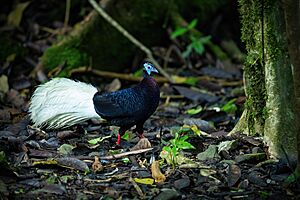Bulwer's pheasant facts for kids
Quick facts for kids Bulwer's pheasant |
|
|---|---|
 |
|
| Wild adult male in Sabah, Malaysia | |
| Conservation status | |
| Scientific classification | |
| Genus: |
Lophura
|
| Species: |
bulweri
|
| Synonyms | |
|
Lobiophasis bulweri |
|
The Bulwer's pheasant (Lophura bulweri) is a super cool bird found only in the forests of Borneo, a large island in Southeast Asia. You might also hear it called the Bulwer's wattled pheasant or the white-tailed wattled pheasant. This amazing bird is part of the Phasianidae family, which includes pheasants, partridges, and chickens. Sadly, it's currently listed as a Vulnerable animal by the IUCN, meaning its population is decreasing and it needs our help!
Contents
What's in a Name? The Bulwer's Pheasant Story
The Bulwer's pheasant belongs to a group of birds called Galliformes. This group includes many ground-dwelling birds like chickens and turkeys.
The first part of its scientific name, Lophura, comes from the Greek word lophos. This word means "ridge," "crest," or "tuft," which probably refers to a feature on some birds in this group.
The second part of its name, bulweri, is a tribute to a person! It was named after Sir Henry Ernest Gascoyne Bulwer. He was the Governor of Labuan from 1871 to 1875. Sir Henry was the one who gave the very first example of this bird to the British Museum.
Meet the Bulwer's Pheasant: What Do They Look Like?
Bulwer's pheasants are known for being sexually dimorphic. This means that male and female birds look very different from each other.
The Dashing Male Pheasant
Male Bulwer's pheasants are quite striking! They can grow to be about 80 centimeters (31 inches) long. Their feathers are mostly black, with a beautiful maroon (dark reddish-purple) chest. They have bright crimson (deep red) legs.
One of their most amazing features is their tail. It's pure white and made of long, curved feathers. They also have bright blue skin on their face. On the sides of their head, they have two bright blue flaps of skin called wattles. These wattles can hide the sides of their head.
The Subtle Female Pheasant
Female Bulwer's pheasants are smaller, usually around 55 centimeters (22 inches) long. They are a dull brown color all over, which helps them blend in with their surroundings. Like the males, they have red legs and blue skin on their face.
Where Do Bulwer's Pheasants Live?
Bulwer's pheasants are found only on the island of Borneo. This makes them an endemic species, meaning they live nowhere else in the world naturally.
Their Forest Home
While these birds can be hard to find in many places, they are more common in protected areas. For example, you might find them in Kayan Mentarang National Park in East Kalimantan.
They prefer to live in hill and lower montane tropical forests. This means they like the rainforests found in the highlands, or mountains. They rarely visit the lowlands, especially areas below 300 meters (980 feet) in altitude.
What's on the Menu?
Bulwer's pheasants enjoy a varied diet. They mainly eat fruits, but they also like to snack on worms and insects.
Why Are Bulwer's Pheasants in Danger?
The Bulwer's pheasant is listed as Vulnerable on the IUCN Red List. This means their numbers are going down quickly.
Threats to Their Home
The main reasons for their decline are habitat loss and fragmentation. This happens when their forest homes are destroyed or broken up into smaller pieces.
- Commercial logging: Trees are cut down for wood, which removes the birds' homes.
- Forest fires: Fires can destroy large areas of their habitat.
Other Dangers
Hunting by local people is also thought to be a problem for these birds. It can make their population even smaller.
Sadly, even programs that try to breed these birds in zoos to help save them haven't been very successful. John Roach from National Geographic once shared an interesting idea. He mentioned that the birds themselves "seem to find each other somewhat less than appealing" when talking about mating. This was based on a conversation with ornithologist John Rowden from the Wildlife Conservation Society.
Bulwer's Pheasants in Zoos
It's very rare to see Bulwer's pheasants in zoos. This is mainly because they have trouble mating when they are in captivity.
Past Homes in Zoos
In the past, a few zoos in the western world have housed these birds:
- The San Diego Zoo once had three male pheasants.
- The San Antonio Zoo had a mother and son pair in the year 2000.
However, neither of these zoos listed the bird as an exhibit in 2017.
European Efforts
Some European zoos have had more success:
- Walsrode Bird Park in Germany kept these birds as recently as 2003.
- Antwerp Zoo in Belgium has even managed to breed them. Antwerp Zoo has been very good at breeding many birds from the Lophura group.
- In 2018, two males arrived at Pairi Daiza in Belgium. At that time, it was the only zoo in Europe with this species. Sadly, one of these birds died in 2022 due to a fox attack.


